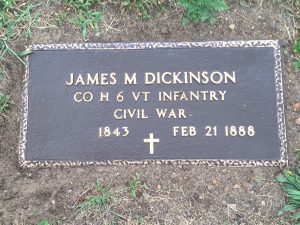 My great-great-great-grandfather, Elijah Dickinson, enlisted in Union Army in 1862. He was joined by both of his brothers, Atwood and James, as well as their sister’s husband, Nelson Cohaskey. The four of them served in Vermont’s 6th Infantry. Elijah died of disease during the war and is buried in Washington, D.C. Nelson also died while serving and is buried in Annapolis, Maryland. Atwood survived the war, moved from Vermont to Iowa, and is buried there. Continue reading Honoring a Civil War veteran
My great-great-great-grandfather, Elijah Dickinson, enlisted in Union Army in 1862. He was joined by both of his brothers, Atwood and James, as well as their sister’s husband, Nelson Cohaskey. The four of them served in Vermont’s 6th Infantry. Elijah died of disease during the war and is buried in Washington, D.C. Nelson also died while serving and is buried in Annapolis, Maryland. Atwood survived the war, moved from Vermont to Iowa, and is buried there. Continue reading Honoring a Civil War veteran
Monthly Archives: August 2016
A modern Wolsey
[Author’s note: This series of excerpts from the Regina Shober Gray diary began here.]

Beverly Farms, Sunday, 3 August 1879: It seems to me I never suffered more with heat than yesterday & today; blazing, breathless, sultry August weather, without the delicious sea change, which has heretofore given us such refreshment daily at 11 a.m. – the thermom at 93 & 4 for hours – and even at 5 p. m. up to 87! There is some promise of thunder gusts by & by, which may cool us off a little. Continue reading A modern Wolsey
A marriage in the Savoy Chapel
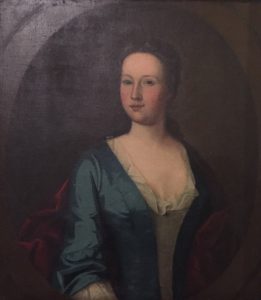
While researching the provenance of a family portrait, I recently revisited the research problem posed by my ancestress Martha (____) (Naden) Mortier, an Englishwoman who came to New York before the American Revolution with her second husband, Abraham Mortier, and her daughters Elizabeth[1] and Ann Naden. As I’ve mentioned before, occasional Google searches on intractable research questions can sometimes yield surprising results, now that so many original documents have been digitized and made available online.
In this case, I went to Ancestry.com to see what I might find. Previous searches on John Naden, the father of Elizabeth and Ann, had never yielded information on his wife, Martha, although her second marriage to Abraham Mortier, in 1754, has long been known. Continue reading A marriage in the Savoy Chapel
A good index guides the reader
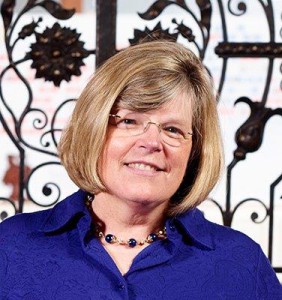 Yesterday, Alicia Crane Williams wrote about the steps she takes when indexing the Early New England Families Study Project, showing the extensive work that makes it possible for us to find ancestors in database searches. But what if you’re not creating a database, but writing a book instead?
Yesterday, Alicia Crane Williams wrote about the steps she takes when indexing the Early New England Families Study Project, showing the extensive work that makes it possible for us to find ancestors in database searches. But what if you’re not creating a database, but writing a book instead?
In the course of your research, have you ever picked up a family history and, to your dismay, found no index? With this experience in mind, if you are writing a family history, you must have an index for your work—at the very least an every-name index. Continue reading A good index guides the reader
Creating an index
 I am in the last phases of preparing eight new Early New England Families Study Project sketches for publication on americanancestors.org in the next week or so. I will give full details about each in an upcoming post.
I am in the last phases of preparing eight new Early New England Families Study Project sketches for publication on americanancestors.org in the next week or so. I will give full details about each in an upcoming post.
First, I have to create the indexes. Indexing a database for the NEHGS website involves a lot more than a simple name or place index. Using an Excel spreadsheet, there are nineteen fields of information to be entered for each record. Most are self-explanatory, but I have added a few notes for those that may not be: Continue reading Creating an index
Real photos
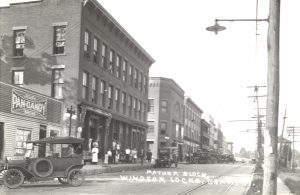 A few weeks ago, I went to one of the regular postcard shows that I frequent in the summer and came across a postcard that fills in a missing image in my family history. My entire postcard collection consists of images from Windsor Locks, Connecticut, where my Italian ancestors settled and lived for multiple generations. I have many of the mass-produced ones as well as some real photo postcards that show the flooding of the Connecticut River in 1936 and others showing houses that no longer stand. Continue reading Real photos
A few weeks ago, I went to one of the regular postcard shows that I frequent in the summer and came across a postcard that fills in a missing image in my family history. My entire postcard collection consists of images from Windsor Locks, Connecticut, where my Italian ancestors settled and lived for multiple generations. I have many of the mass-produced ones as well as some real photo postcards that show the flooding of the Connecticut River in 1936 and others showing houses that no longer stand. Continue reading Real photos
‘A crescent moon followed the day god down’
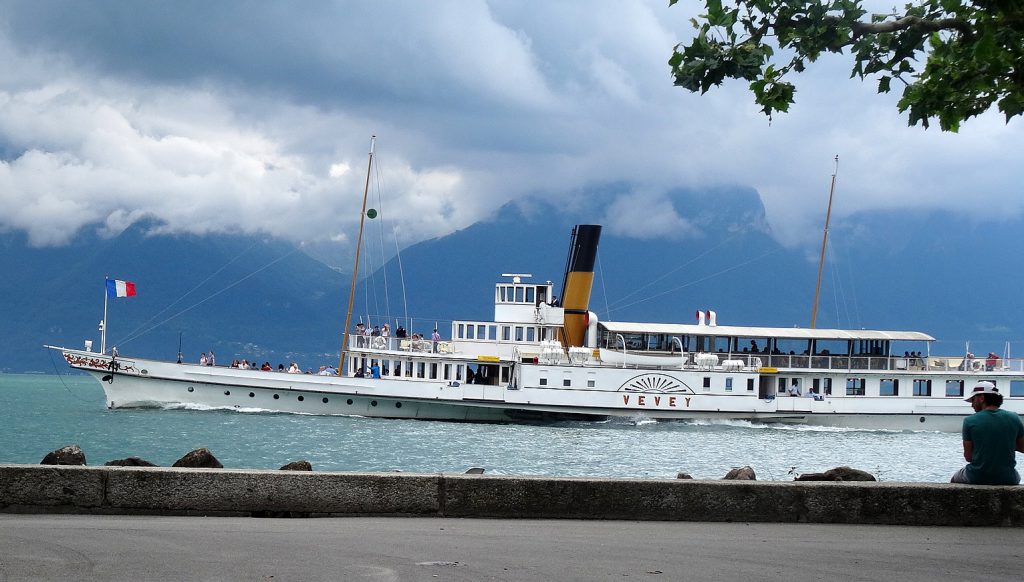
[Author’s note: This series of excerpts from the Regina Shober Gray diary began here.]
For those of us wiling away the summer in offices in the United States, yearning for a glimpse of blue water, here is a living portrait of a Swiss summer 138 years ago from the Gray[1] diary:
Hotel Monnet, ou “Les Trois Couronnes,” Vevey, Sunday, 4 August 1878: We are delightfully accommodated here; our rooms, including a handsome parlor with a broad balcony to our own use, look upon the lake, and to-day there has been a rowing race, wh. we watched with some interest; a sailing regatta fails to take place for want of a wind. The weather to-day has been lovely – but it seems clouding over now. Continue reading ‘A crescent moon followed the day god down’
A favorite relative
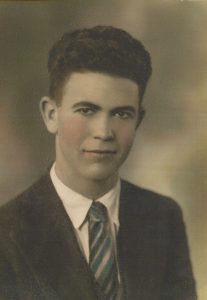 We all have one – the favorite relative. And after all this time as a genealogist, I would love to talk to a sociologist or psychiatrist about our inclination towards a certain person. Does it tell us something about ourselves? Do we see ourselves in one ancestor and not another? For me, I often obsessively research those ancestors I have deemed great, resilient people. I often wonder how my ancestors survived – how could someone raise 15 children in the eighteenth century? How could someone forgive their mother after abandoning them in Ireland to move to New York City? How do parents go on after losing a child? Continue reading A favorite relative
We all have one – the favorite relative. And after all this time as a genealogist, I would love to talk to a sociologist or psychiatrist about our inclination towards a certain person. Does it tell us something about ourselves? Do we see ourselves in one ancestor and not another? For me, I often obsessively research those ancestors I have deemed great, resilient people. I often wonder how my ancestors survived – how could someone raise 15 children in the eighteenth century? How could someone forgive their mother after abandoning them in Ireland to move to New York City? How do parents go on after losing a child? Continue reading A favorite relative
‘May we have strength’

The 1878 Gray diary[1] is unusual in filling two full volumes instead of the more usual single one Mrs. Gray devoted to the events in her life. Volume 1 ends with this entry, one that mixes hope and anxiety, sightseeing and sickbeds.
Hotel Monnet, Vevey,[2] Saturday, 3 August 1878: We left Berne yesterday morning (Friday), having really had, on Thursday, from 7½ to 8½ a.m., a full, magnificent view of the whole great range of snow-clad Alps [and] the Bernese Oberland; and a grand sight it was. There they were in their great, white glory, when I opened my shutters, and I rushed up two flights of stairs to call Mary & Sam [Gray], who felt well repaid for being so unceremoniously disturbed in their morning slumbers. Continue reading ‘May we have strength’
Remember the ladies

Over the years I have had the honor of corresponding with veterans from the Spanish-American War, World War I, and World War II. But I must admit that corresponding and talking with some of the last widows of the Civil War was a highlight as a historian. It is hard for some now to comprehend that a widow of the Civil War could be living nearly 150 years after the start of the war, early in the twenty-first century. However there have been other widows who married very young to older veterans from previous wars with quite similar stories. Continue reading Remember the ladies